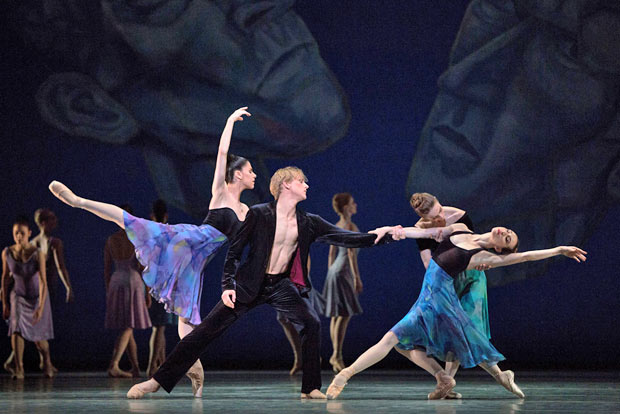
© Marty Sohl. (Click image for larger version)
American Ballet Theatre
Shostakovich Trilogy – Symphony #9, Chamber Symphony, Piano Concerto #1
New York, Metropolitan Opera House
31 May and 1 June (mat) 2013
www.abt.org
Ratmansky Takes on Shostakovich
“I think the audience will have to work a little bit,” Alexei Ratmansky said recently during a public discussion of his new Shostakovich Trilogy. Even though I’ve been periodically sitting in on Ratmansky’s choreographic sessions at ABT for an essay I’m writing about choreography and music and thus was more prepared than some to absorb the full scope of the trilogy at first flush, I’ll admit it took two full performances, on May 31 and June 1, to feel I was even starting to grasp the work. It will take several more to begin to know it. It’s an immensely ambitious project: a full evening of ballets by one choreographer, set to large orchestral works by a single composer. The pieces – the Ninth Symphony and the Chamber Symphony in C minor, plus the Concerto for Piano and Trumpet – span Shostakovich’s career and represent a cross-section of his musical and temperamental styles. Here we see an arc from youthful brilliance (the concerto) to the irony and ambiguity of maturity (the Ninth Symphony) and the discouragement of experience (the Chamber Symphony).
Ratmansky has been mulling the project for years, after discovering the composer as a young ballet student. His first ballets were set to Shostakovich, and he has revisited the composer over the years in The Bright Stream, The Bolt, and, more recently, Concerto DSCH (for New York City Ballet). In addition, Shostakovich is a central, and fraught figure in Russian history, a Soviet composer who both served and eluded the system. His music contains a web of references, to everything from silent movies to patriotic marches and love songs. Needless to say, one comes to the trilogy with high expectations, given the strong impression made last fall by the first section, Symphony #9.
The fall performances were held at City Center, a much more intimate theatre than the Met. At the Met, ballets must struggle against the huge distance from the stage to the last row and, in this case, the rather dim lighting, by Jennifer Tipton. The murky atmosphere makes the eye work twice as hard as it should. Faces are difficult to read, as are the smaller details. There is, after all, so much to see (Ratmansky is no minimalist). And to hear. The ABT orchestra is strained to the limit by the rhythmic and textural variety of these pieces, and not always able to delineate the music with enough clarity. Like the lighting, their playing is hazy.
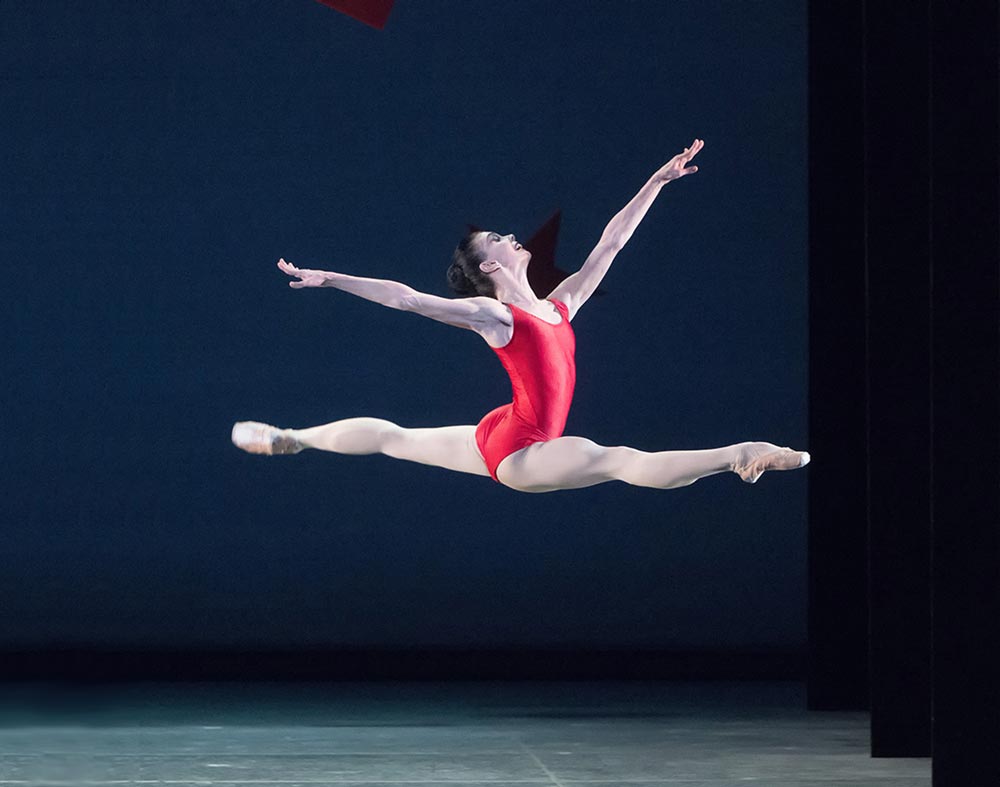
© Gene Schiavone. (Click image for larger version)
But I have to say that after seeing the Shostakovich Trilogy twice, and picking up many more details – including motifs that reappear in two or more of the ballets, creating a sense of cohesion – I found it very compelling indeed, especially the opening and closing ballets. Symphony #9 is as enigmatic as it appeared in the fall. Piano Concerto #1 is a brilliant, quicksilver romp, with a dreamy, expansive pas de deux at its heart and an almost comically speedy finale. In the middle, the Chamber Symphony is a more difficult work, with much to admire, though in my opinion a fundamental tension between its thematic content and the musical structure is never fully resolved. The ballets work well together, and can probably stand alone as well (with the possible exception of the Chamber Symphony). I’m anxious to see them again, convinced that they will reveal many more resonances and connections.
The designs, by George Tsypin, are attractive and leave space for the dancers. In the final work they do more: the bright red constructivist assemblage that hangs above the stage helps to fill the cavernous height of the Met proscenium, gives a sense of depth and sets off the red of the dancers’ costumes. The wardrobe, by Keso Dekker, ranges from elegant and simple (dark stretchy trousers and sleeveless tops for the men and mottled sundresses for the women in Symphony #9) to not terribly attractive (shiny gray pants and black tanks for the men and drab pastel dresses in the Chamber Symphony) to quite stunning (brightly colored, gender-neutral unitards in the Piano Concerto). The Concerto, in particular, is a joy to look at. The red accents lend force to the movements, and an element of humor as well; as the dancers spin, our eye is struck by the red on one side, and gray on the other.
What is most remarkable about the Trilogy is its range, combined with the interweaving of elements from one ballet to the next. Here is a world, Shostakovich’s world as seen by Ratmansky. Each piece has a distinct character, and yet the three clearly come from the same mind, and echo each other in various ways. The changes in tone, within each ballet and over the course of the evening, keep one guessing. Symphony #9 itself, has at least three distinct moods, which Ratmansky manages to weave into a cohesive whole with ideas that overflow from one movement to the next. The beginning, set to a jolly martial tune, is almost too ebullient; one doesn’t know whether to take its high spirits seriously. (The Soviet authorities felt the same way about the symphony itself.) A man leaps into his comrades’ arms; a woman hops on pointe and pretends to play the drums.
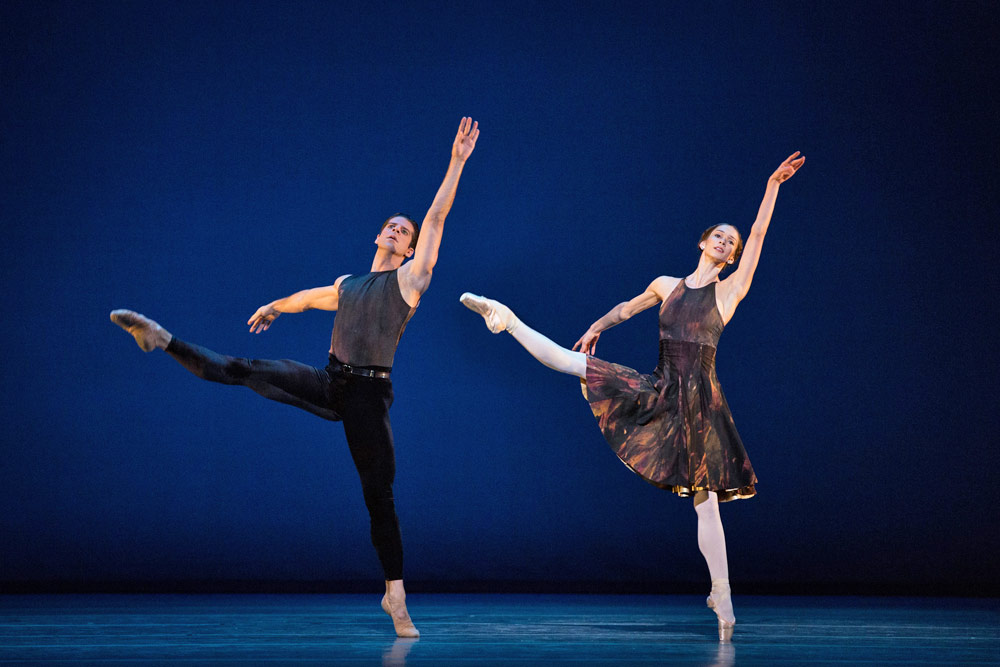
© Marty Sohl. (Click image for larger version)
But even here Ratmansky drops in some seeds of discontent. The lead man begins the ballet alone, in darkness and silence. In the midst of the festivities and heroic marches of the first movement, the lead couple clasps briefly in a tango-like embrace, peering into the wings as if sensing some sort of danger. This leads into a rather creepy pas de deux in the second movement. A second couple (Marcelo Gomes and Polina Semionova on the 31st and Roberto Bolle and Veronika Part on June 1) takes up the theme of danger lurking beyond the margins of the stage, interrupting its push-and-pull duet to glance from side to side on a two-note figure in the music. Again, the tango, with its diagonal lunges and creeping, cat-like steps, makes an appearance (and returns in the Piano Concerto). Symphony #9 introduces other themes that will recur over the course of the evening as well: a motif of collapse and death, which haunts all three ballets, and of angelic (or ghostly) interference in daily life. Simpler things too, like an arabesque penchée that dives to the floor, a swan-like crouch, or groups of dancers grasping at a single figure, return in all three ballets. Even death has many facets in Ratmansky’s hands; tragic, playfully impermanent, purely abstract.
As one might expect, the Chamber Symphony is the darkest, most turbulent of the three ballets, both by placement and by selection of music. The symphony is actually an orchestrated version of a quartet, the Eighth, laden with heavy autobiographical references and quotations from Shostakovich’s own music. The four-note figure D-E flat-C-B, a transcription of Shostakovich’s initials in German, is repeated like a desperate mantra, as if the composer were saying: “Me, me, me!” The work was written at time when he was close to despair. Because of its gloominess and the repetition that is built into its structure, it presents serious challenges to the choreographer. Ratmansky has turned the ballet into a kind of allegory of the struggle of the artist, perhaps Shostakovich himself. A man (David Hallberg on May 31st, James Whiteside on June 1) struggles with his demons, who appear as shadowy figures that grasp at his arms and pull him this way and that. The man flails and twists, falls and rises again. Hallberg was especially terrifying in this role, wild-eyed, his endless, elegant limbs flying in all directions. As a friend noted at intermission, he looked like a junky in the throes of withdrawal.

© Marty Sohl. (Click image for larger version)
Ratmansky opens the work with a striking motif of swooping angels – women being lifted and lowered by their partners, legs held behind them like swallow’s tails. (As always, the ensemble is kept very busy.) Later, three women appear on the scene, perhaps representing three muses or loves. But somewhere in the midst of all this seduction and turbulence, the ballet loses focus. The choreographer’s tendency to fill the stage with activity, especially when the music churns through passages of nervous inertia, creates a feeling of aimlessness. An encounter with one of the three women is lost in a constant stream of dancers. The unstructured sound of the ABT orchestra becomes particularly problematic here. For a while, it feels as if the ballet were adrift. Until, finally, it finds its footing again in a poignant pas de deux between the central man and one of the three women (Paloma Herrera on opening night, Yuriko Kajiya at the matinée). The two dance together briefly but, as three slashing chords interrupt the flow, the woman crumples to the ground. A haunting, lyrical dance of death follows. The man lies down next to a row of four other bodies, as if he has decided to die. The woman returns, carried through the air by four men. Each time he reaches for her, they swoop her away in an arc. The image is both beautifully realized and deeply poignant. In the end, as the man begins to regain strength, he turns toward the ensemble and appears to mold its contours with his arms. Slowly the dancers coalesce into an arresting formation, a kind of living sculpture, built up from the outside, with dancers lying on the floor and others in diagonal poses, and a statue-like figure in the center. A metaphor for music, perhaps. It’s a visual coup de théâtre, and, as far as I know, a first for Ratmansky. Is it also a bit heavy-handed? Could be. It will take more viewings to tell.
In response to this foray into literal meaning, he has made a final ballet (Piano Concerto #1) that is almost free of content. It is simply dazzling on its own terms. In the first cast, Diana Vishneva and Natalia Osipova, two women locked in a kind of mad competition, were fascinating to watch as they circled each other, or galloped across the stage in broad skating movements. What two great ballerinas could be more different from each other? (The following performance, danced by Xiomara Reyes and the young Christine Shevchenko, stepping in for an injured Gillian Murphy, was less high-powered, but still worked.) The choreographer has saved up much of his firepower – with the exception of a vivid display in the first ballet for Herman Cornejo – for the Concerto. It seems to dash by at an impossible speed. Spinning leaps, split jumps, a circle of flying brisés volés executed around an ingeniously designed chain of men, whip-fast vortices of turns. (And a playful chase, reminiscent of Rubies.) On opening night, Osipova flew across the stage in a series of grand jetés that left the audience gasping. (Also in the first cast, Ivan Vasiliev was brilliantly clown-like, a force of nature, well contrasted with the sensuality and stretch of Cory Stearns. In the second cast, Daniil Simkin, more airy and light, was cast with Calvin Royal III, a young member of the corps, who danced with limpid grace and quiet intensity. Keep your eye on Mr. Royal.)

© Gene Schiavone. (Click image for larger version)
Crucially, none of these feats are accomplished merely for show: the steps echo the music with great precision. In fact they seem to get inside the music, making us hear it more clearly. The arms, in particular, sing the lush, giddy melodies of the piano, while the feet play with the patter of the trumpet. A pretty, French-sounding melody in the third movement is illustrated in the simplest terms by a line of women turning backward and forward, flashing gray, red, gray, red. Such stylish touches abound, as when one of the ballerinas is held in a twisted attitude by four men, each of whom releases her in turn, leaving her in an unadorned balance, like an art deco statue. The pas de deux for Cory Stearns and Diana Vishneva (Calvin Royal and Christine Shevchenko in the second cast) is one of Ratmansky’s most swooning, echoing the theme of the elusive lover from previous ballets. In this case, the woman bourrées away from him, tracing a sinuous figure eight. The finale, set to one of Shostakovich’s most raucous accellerandi, is almost mind-numbingly fast and filled with tricks. It’s a great ending to one of the most ambitious, elaborately conceived new ballets we’ve seen in a long time. The company has never looked better. With just a little more light, it could be even more dazzling.














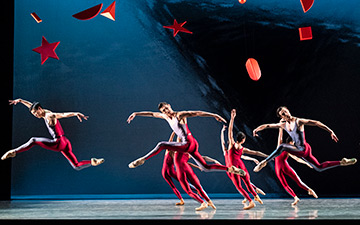
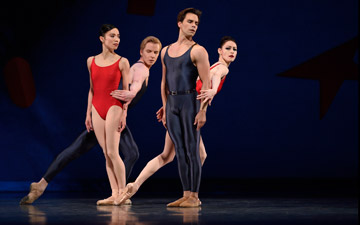
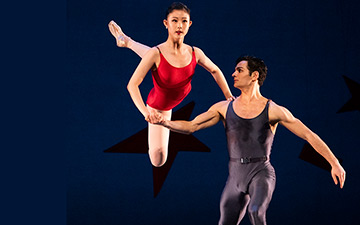
You must be logged in to post a comment.